Depression in Adult Men: Exploring Help Seeking and Treatment Options
VerifiedAdded on 2023/06/07
|10
|2878
|471
Essay
AI Summary
This essay explores the multifaceted issue of depression in adult men, analyzing the factors that contribute to its prevalence and the societal and psychological barriers that often prevent men from seeking professional help. It examines the impact of gender stereotypes, societal expectations of strength and independence, and the reluctance to express vulnerability. The essay further delves into the various evidence-based interventions available to treat depression in men, including cognitive behavioral therapy, narrative therapy, music therapy, and the importance of awareness programs and support networks. It highlights the significance of addressing the stigma associated with mental health and promoting strategies to encourage help-seeking behaviors, ultimately emphasizing the need for a comprehensive approach to improve the mental well-being of men. The essay concludes by advocating for increased awareness, compulsory counselling sessions, and the integration of mental health support within educational and professional settings.
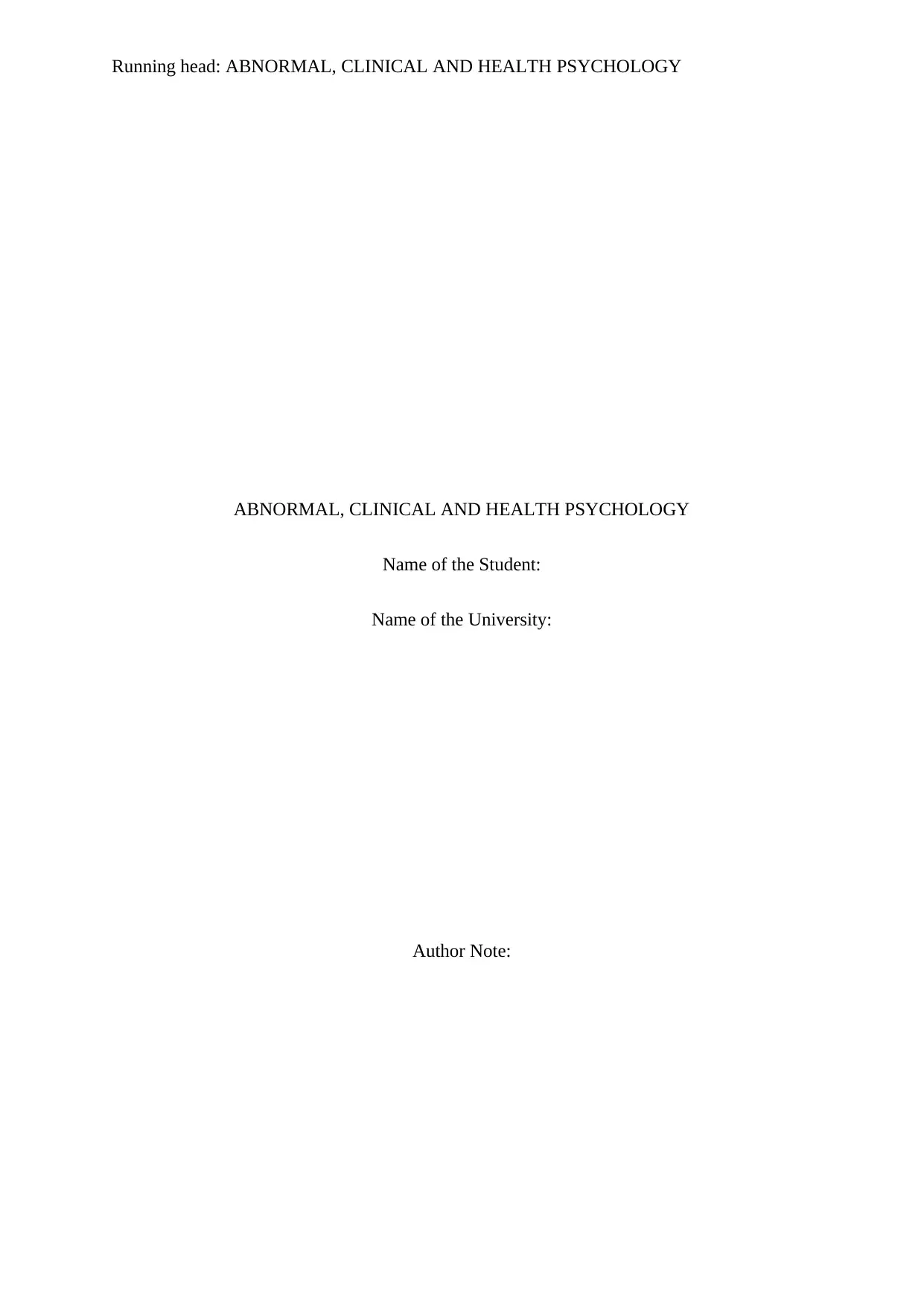
Running head: ABNORMAL, CLINICAL AND HEALTH PSYCHOLOGY
ABNORMAL, CLINICAL AND HEALTH PSYCHOLOGY
Name of the Student:
Name of the University:
Author Note:
ABNORMAL, CLINICAL AND HEALTH PSYCHOLOGY
Name of the Student:
Name of the University:
Author Note:
Paraphrase This Document
Need a fresh take? Get an instant paraphrase of this document with our AI Paraphraser
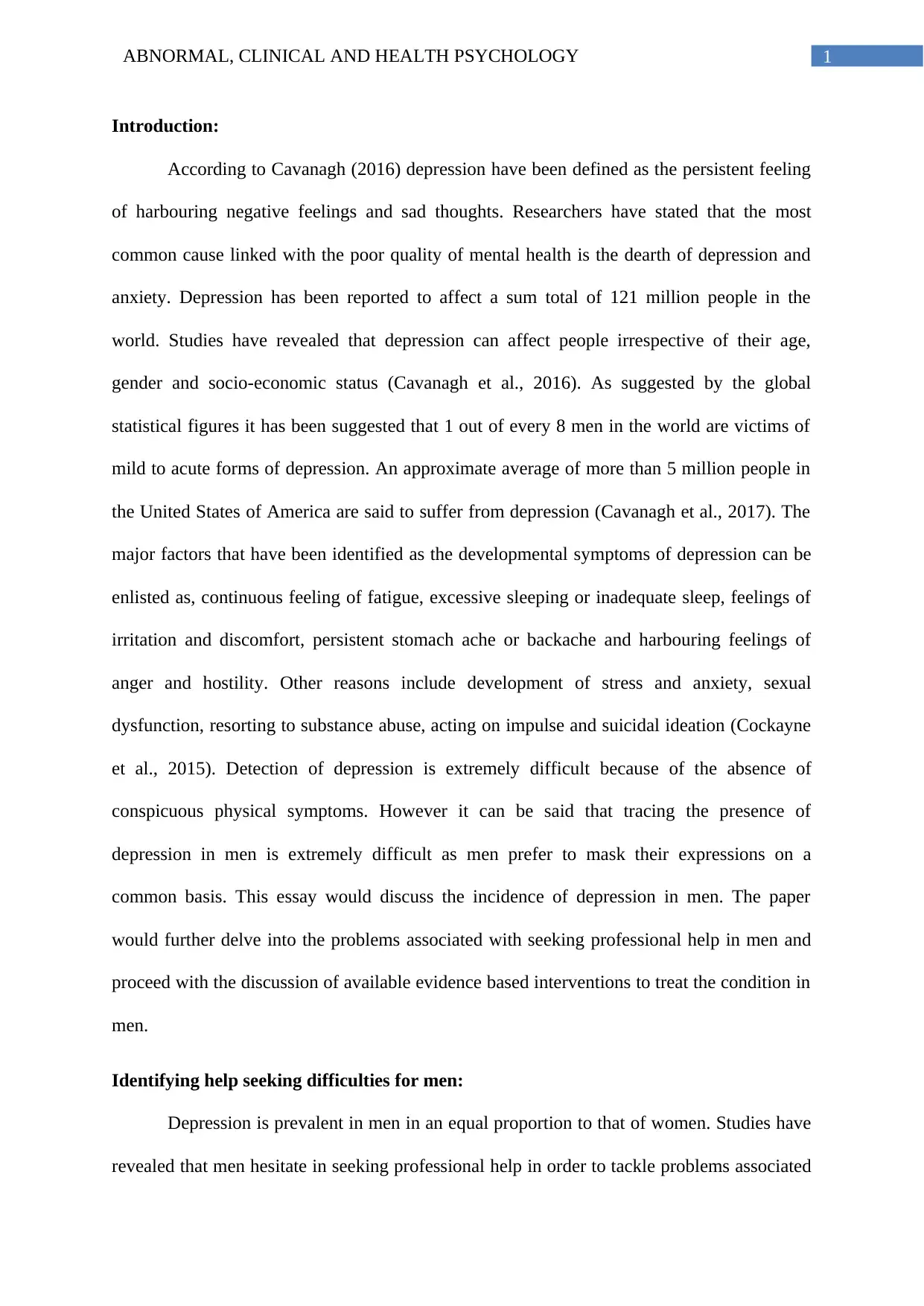
1ABNORMAL, CLINICAL AND HEALTH PSYCHOLOGY
Introduction:
According to Cavanagh (2016) depression have been defined as the persistent feeling
of harbouring negative feelings and sad thoughts. Researchers have stated that the most
common cause linked with the poor quality of mental health is the dearth of depression and
anxiety. Depression has been reported to affect a sum total of 121 million people in the
world. Studies have revealed that depression can affect people irrespective of their age,
gender and socio-economic status (Cavanagh et al., 2016). As suggested by the global
statistical figures it has been suggested that 1 out of every 8 men in the world are victims of
mild to acute forms of depression. An approximate average of more than 5 million people in
the United States of America are said to suffer from depression (Cavanagh et al., 2017). The
major factors that have been identified as the developmental symptoms of depression can be
enlisted as, continuous feeling of fatigue, excessive sleeping or inadequate sleep, feelings of
irritation and discomfort, persistent stomach ache or backache and harbouring feelings of
anger and hostility. Other reasons include development of stress and anxiety, sexual
dysfunction, resorting to substance abuse, acting on impulse and suicidal ideation (Cockayne
et al., 2015). Detection of depression is extremely difficult because of the absence of
conspicuous physical symptoms. However it can be said that tracing the presence of
depression in men is extremely difficult as men prefer to mask their expressions on a
common basis. This essay would discuss the incidence of depression in men. The paper
would further delve into the problems associated with seeking professional help in men and
proceed with the discussion of available evidence based interventions to treat the condition in
men.
Identifying help seeking difficulties for men:
Depression is prevalent in men in an equal proportion to that of women. Studies have
revealed that men hesitate in seeking professional help in order to tackle problems associated
Introduction:
According to Cavanagh (2016) depression have been defined as the persistent feeling
of harbouring negative feelings and sad thoughts. Researchers have stated that the most
common cause linked with the poor quality of mental health is the dearth of depression and
anxiety. Depression has been reported to affect a sum total of 121 million people in the
world. Studies have revealed that depression can affect people irrespective of their age,
gender and socio-economic status (Cavanagh et al., 2016). As suggested by the global
statistical figures it has been suggested that 1 out of every 8 men in the world are victims of
mild to acute forms of depression. An approximate average of more than 5 million people in
the United States of America are said to suffer from depression (Cavanagh et al., 2017). The
major factors that have been identified as the developmental symptoms of depression can be
enlisted as, continuous feeling of fatigue, excessive sleeping or inadequate sleep, feelings of
irritation and discomfort, persistent stomach ache or backache and harbouring feelings of
anger and hostility. Other reasons include development of stress and anxiety, sexual
dysfunction, resorting to substance abuse, acting on impulse and suicidal ideation (Cockayne
et al., 2015). Detection of depression is extremely difficult because of the absence of
conspicuous physical symptoms. However it can be said that tracing the presence of
depression in men is extremely difficult as men prefer to mask their expressions on a
common basis. This essay would discuss the incidence of depression in men. The paper
would further delve into the problems associated with seeking professional help in men and
proceed with the discussion of available evidence based interventions to treat the condition in
men.
Identifying help seeking difficulties for men:
Depression is prevalent in men in an equal proportion to that of women. Studies have
revealed that men hesitate in seeking professional help in order to tackle problems associated
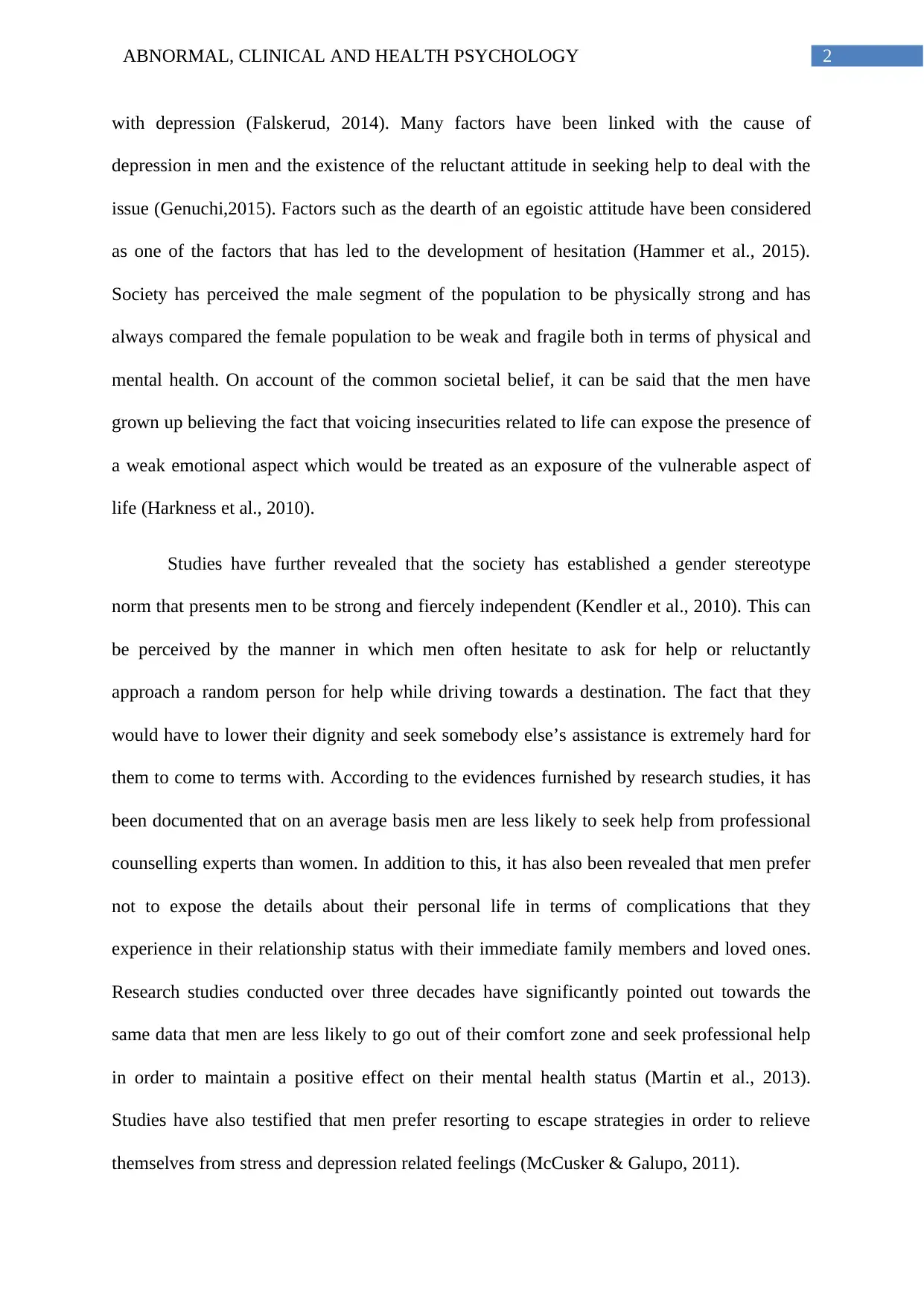
2ABNORMAL, CLINICAL AND HEALTH PSYCHOLOGY
with depression (Falskerud, 2014). Many factors have been linked with the cause of
depression in men and the existence of the reluctant attitude in seeking help to deal with the
issue (Genuchi,2015). Factors such as the dearth of an egoistic attitude have been considered
as one of the factors that has led to the development of hesitation (Hammer et al., 2015).
Society has perceived the male segment of the population to be physically strong and has
always compared the female population to be weak and fragile both in terms of physical and
mental health. On account of the common societal belief, it can be said that the men have
grown up believing the fact that voicing insecurities related to life can expose the presence of
a weak emotional aspect which would be treated as an exposure of the vulnerable aspect of
life (Harkness et al., 2010).
Studies have further revealed that the society has established a gender stereotype
norm that presents men to be strong and fiercely independent (Kendler et al., 2010). This can
be perceived by the manner in which men often hesitate to ask for help or reluctantly
approach a random person for help while driving towards a destination. The fact that they
would have to lower their dignity and seek somebody else’s assistance is extremely hard for
them to come to terms with. According to the evidences furnished by research studies, it has
been documented that on an average basis men are less likely to seek help from professional
counselling experts than women. In addition to this, it has also been revealed that men prefer
not to expose the details about their personal life in terms of complications that they
experience in their relationship status with their immediate family members and loved ones.
Research studies conducted over three decades have significantly pointed out towards the
same data that men are less likely to go out of their comfort zone and seek professional help
in order to maintain a positive effect on their mental health status (Martin et al., 2013).
Studies have also testified that men prefer resorting to escape strategies in order to relieve
themselves from stress and depression related feelings (McCusker & Galupo, 2011).
with depression (Falskerud, 2014). Many factors have been linked with the cause of
depression in men and the existence of the reluctant attitude in seeking help to deal with the
issue (Genuchi,2015). Factors such as the dearth of an egoistic attitude have been considered
as one of the factors that has led to the development of hesitation (Hammer et al., 2015).
Society has perceived the male segment of the population to be physically strong and has
always compared the female population to be weak and fragile both in terms of physical and
mental health. On account of the common societal belief, it can be said that the men have
grown up believing the fact that voicing insecurities related to life can expose the presence of
a weak emotional aspect which would be treated as an exposure of the vulnerable aspect of
life (Harkness et al., 2010).
Studies have further revealed that the society has established a gender stereotype
norm that presents men to be strong and fiercely independent (Kendler et al., 2010). This can
be perceived by the manner in which men often hesitate to ask for help or reluctantly
approach a random person for help while driving towards a destination. The fact that they
would have to lower their dignity and seek somebody else’s assistance is extremely hard for
them to come to terms with. According to the evidences furnished by research studies, it has
been documented that on an average basis men are less likely to seek help from professional
counselling experts than women. In addition to this, it has also been revealed that men prefer
not to expose the details about their personal life in terms of complications that they
experience in their relationship status with their immediate family members and loved ones.
Research studies conducted over three decades have significantly pointed out towards the
same data that men are less likely to go out of their comfort zone and seek professional help
in order to maintain a positive effect on their mental health status (Martin et al., 2013).
Studies have also testified that men prefer resorting to escape strategies in order to relieve
themselves from stress and depression related feelings (McCusker & Galupo, 2011).
⊘ This is a preview!⊘
Do you want full access?
Subscribe today to unlock all pages.

Trusted by 1+ million students worldwide
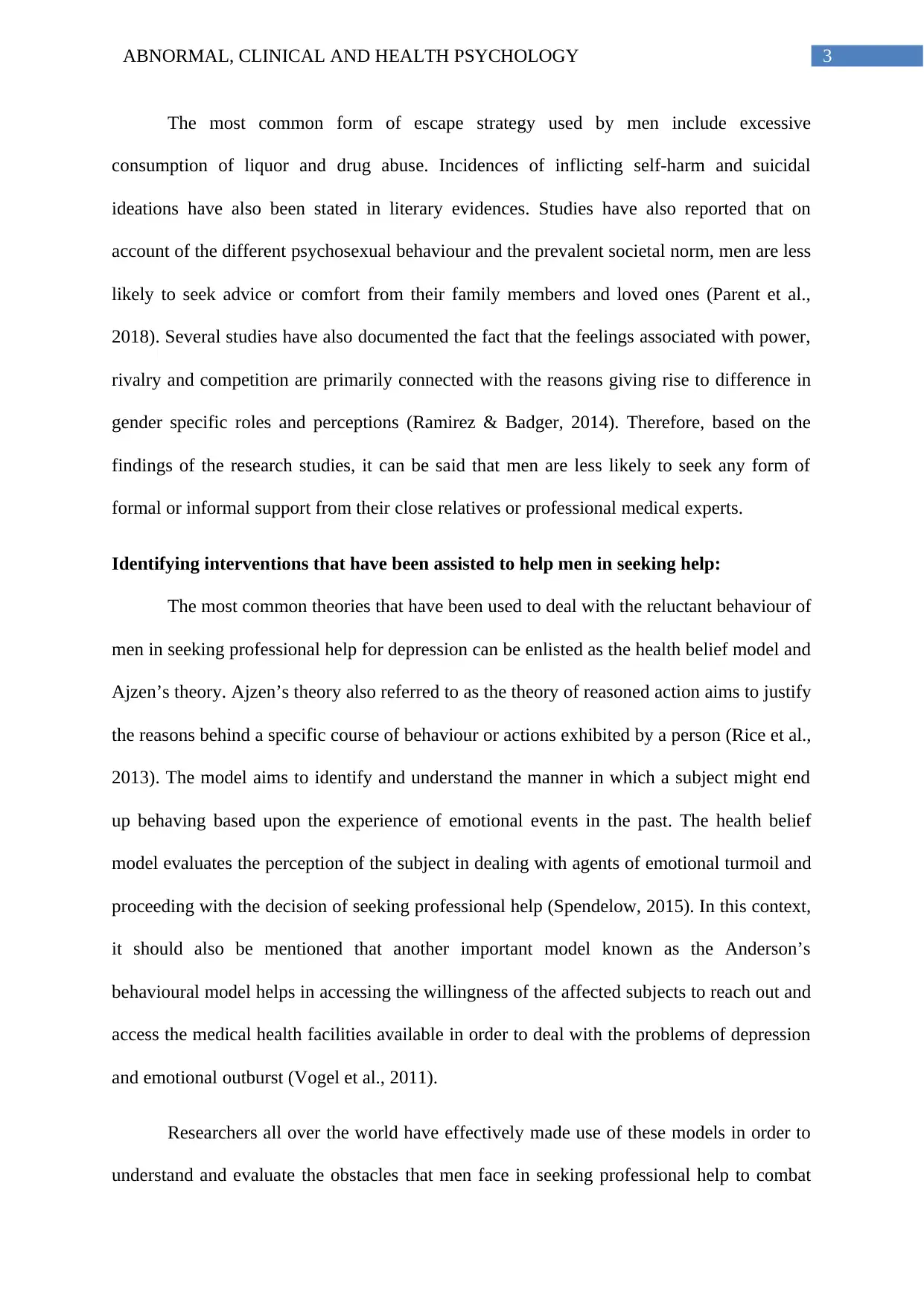
3ABNORMAL, CLINICAL AND HEALTH PSYCHOLOGY
The most common form of escape strategy used by men include excessive
consumption of liquor and drug abuse. Incidences of inflicting self-harm and suicidal
ideations have also been stated in literary evidences. Studies have also reported that on
account of the different psychosexual behaviour and the prevalent societal norm, men are less
likely to seek advice or comfort from their family members and loved ones (Parent et al.,
2018). Several studies have also documented the fact that the feelings associated with power,
rivalry and competition are primarily connected with the reasons giving rise to difference in
gender specific roles and perceptions (Ramirez & Badger, 2014). Therefore, based on the
findings of the research studies, it can be said that men are less likely to seek any form of
formal or informal support from their close relatives or professional medical experts.
Identifying interventions that have been assisted to help men in seeking help:
The most common theories that have been used to deal with the reluctant behaviour of
men in seeking professional help for depression can be enlisted as the health belief model and
Ajzen’s theory. Ajzen’s theory also referred to as the theory of reasoned action aims to justify
the reasons behind a specific course of behaviour or actions exhibited by a person (Rice et al.,
2013). The model aims to identify and understand the manner in which a subject might end
up behaving based upon the experience of emotional events in the past. The health belief
model evaluates the perception of the subject in dealing with agents of emotional turmoil and
proceeding with the decision of seeking professional help (Spendelow, 2015). In this context,
it should also be mentioned that another important model known as the Anderson’s
behavioural model helps in accessing the willingness of the affected subjects to reach out and
access the medical health facilities available in order to deal with the problems of depression
and emotional outburst (Vogel et al., 2011).
Researchers all over the world have effectively made use of these models in order to
understand and evaluate the obstacles that men face in seeking professional help to combat
The most common form of escape strategy used by men include excessive
consumption of liquor and drug abuse. Incidences of inflicting self-harm and suicidal
ideations have also been stated in literary evidences. Studies have also reported that on
account of the different psychosexual behaviour and the prevalent societal norm, men are less
likely to seek advice or comfort from their family members and loved ones (Parent et al.,
2018). Several studies have also documented the fact that the feelings associated with power,
rivalry and competition are primarily connected with the reasons giving rise to difference in
gender specific roles and perceptions (Ramirez & Badger, 2014). Therefore, based on the
findings of the research studies, it can be said that men are less likely to seek any form of
formal or informal support from their close relatives or professional medical experts.
Identifying interventions that have been assisted to help men in seeking help:
The most common theories that have been used to deal with the reluctant behaviour of
men in seeking professional help for depression can be enlisted as the health belief model and
Ajzen’s theory. Ajzen’s theory also referred to as the theory of reasoned action aims to justify
the reasons behind a specific course of behaviour or actions exhibited by a person (Rice et al.,
2013). The model aims to identify and understand the manner in which a subject might end
up behaving based upon the experience of emotional events in the past. The health belief
model evaluates the perception of the subject in dealing with agents of emotional turmoil and
proceeding with the decision of seeking professional help (Spendelow, 2015). In this context,
it should also be mentioned that another important model known as the Anderson’s
behavioural model helps in accessing the willingness of the affected subjects to reach out and
access the medical health facilities available in order to deal with the problems of depression
and emotional outburst (Vogel et al., 2011).
Researchers all over the world have effectively made use of these models in order to
understand and evaluate the obstacles that men face in seeking professional help to combat
Paraphrase This Document
Need a fresh take? Get an instant paraphrase of this document with our AI Paraphraser
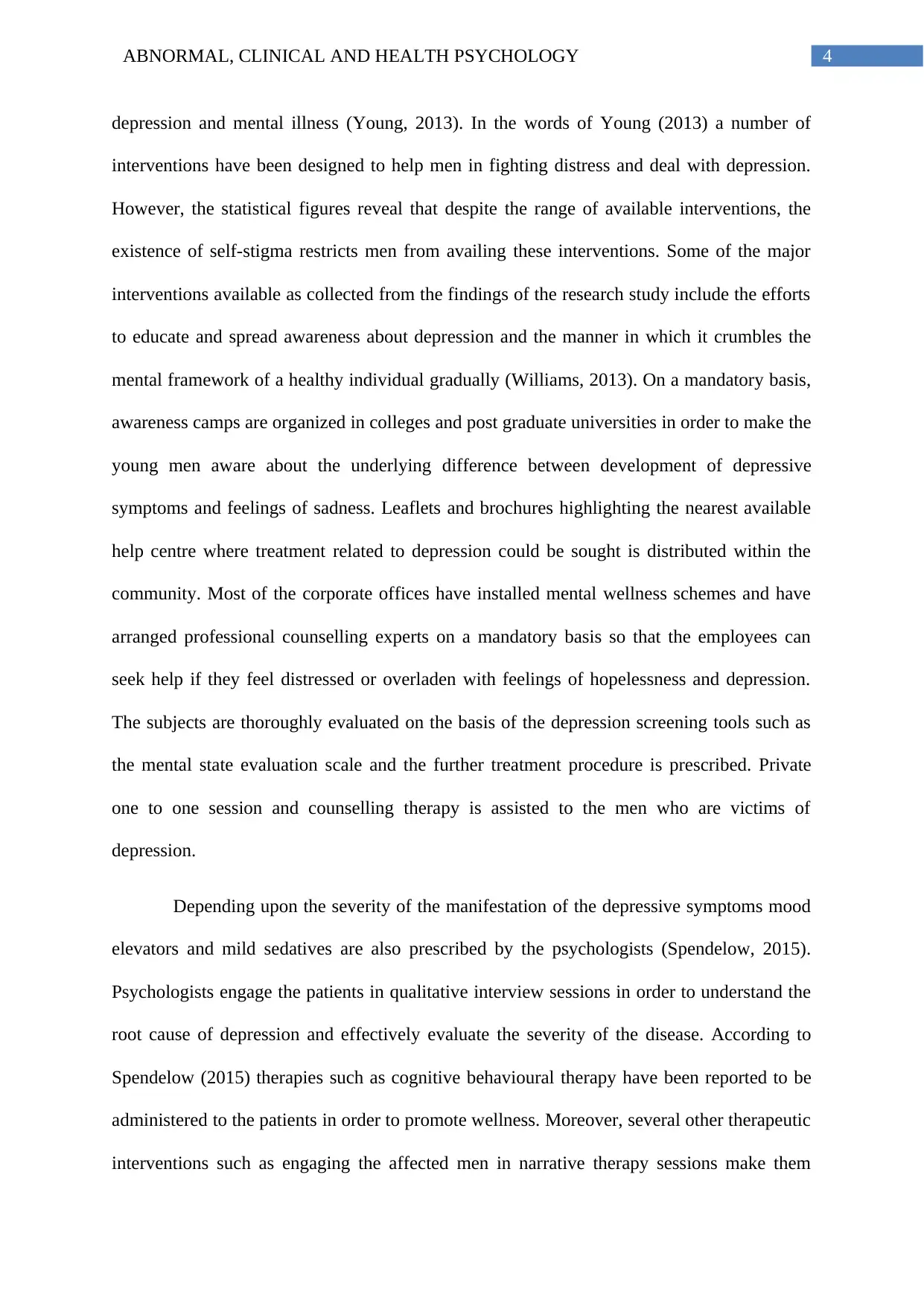
4ABNORMAL, CLINICAL AND HEALTH PSYCHOLOGY
depression and mental illness (Young, 2013). In the words of Young (2013) a number of
interventions have been designed to help men in fighting distress and deal with depression.
However, the statistical figures reveal that despite the range of available interventions, the
existence of self-stigma restricts men from availing these interventions. Some of the major
interventions available as collected from the findings of the research study include the efforts
to educate and spread awareness about depression and the manner in which it crumbles the
mental framework of a healthy individual gradually (Williams, 2013). On a mandatory basis,
awareness camps are organized in colleges and post graduate universities in order to make the
young men aware about the underlying difference between development of depressive
symptoms and feelings of sadness. Leaflets and brochures highlighting the nearest available
help centre where treatment related to depression could be sought is distributed within the
community. Most of the corporate offices have installed mental wellness schemes and have
arranged professional counselling experts on a mandatory basis so that the employees can
seek help if they feel distressed or overladen with feelings of hopelessness and depression.
The subjects are thoroughly evaluated on the basis of the depression screening tools such as
the mental state evaluation scale and the further treatment procedure is prescribed. Private
one to one session and counselling therapy is assisted to the men who are victims of
depression.
Depending upon the severity of the manifestation of the depressive symptoms mood
elevators and mild sedatives are also prescribed by the psychologists (Spendelow, 2015).
Psychologists engage the patients in qualitative interview sessions in order to understand the
root cause of depression and effectively evaluate the severity of the disease. According to
Spendelow (2015) therapies such as cognitive behavioural therapy have been reported to be
administered to the patients in order to promote wellness. Moreover, several other therapeutic
interventions such as engaging the affected men in narrative therapy sessions make them
depression and mental illness (Young, 2013). In the words of Young (2013) a number of
interventions have been designed to help men in fighting distress and deal with depression.
However, the statistical figures reveal that despite the range of available interventions, the
existence of self-stigma restricts men from availing these interventions. Some of the major
interventions available as collected from the findings of the research study include the efforts
to educate and spread awareness about depression and the manner in which it crumbles the
mental framework of a healthy individual gradually (Williams, 2013). On a mandatory basis,
awareness camps are organized in colleges and post graduate universities in order to make the
young men aware about the underlying difference between development of depressive
symptoms and feelings of sadness. Leaflets and brochures highlighting the nearest available
help centre where treatment related to depression could be sought is distributed within the
community. Most of the corporate offices have installed mental wellness schemes and have
arranged professional counselling experts on a mandatory basis so that the employees can
seek help if they feel distressed or overladen with feelings of hopelessness and depression.
The subjects are thoroughly evaluated on the basis of the depression screening tools such as
the mental state evaluation scale and the further treatment procedure is prescribed. Private
one to one session and counselling therapy is assisted to the men who are victims of
depression.
Depending upon the severity of the manifestation of the depressive symptoms mood
elevators and mild sedatives are also prescribed by the psychologists (Spendelow, 2015).
Psychologists engage the patients in qualitative interview sessions in order to understand the
root cause of depression and effectively evaluate the severity of the disease. According to
Spendelow (2015) therapies such as cognitive behavioural therapy have been reported to be
administered to the patients in order to promote wellness. Moreover, several other therapeutic
interventions such as engaging the affected men in narrative therapy sessions make them

5ABNORMAL, CLINICAL AND HEALTH PSYCHOLOGY
open up about their personal issues which provides a magnified image about the underlying
complication and effectively help the affected people to recover. Additionally, it should also
be noted that engaging men in activities such as taking up an additional hobby has been
reported to contribute immensely in channelizing the energy into something positive and at
the same time maintain an optimistic approach towards life. Spending quality time with
family members and friends have also been reported to be prescribed to men affected with
depression in order to relieve themselves and recover completely. Rehabilitation camps have
also been found to be extremely effective in helping men to deal with depression. These
camps primarily focus on reducing the consumption habits of men and direct them towards
leading a healthy and normal life. It should also be critically noted that music therapy has
been reported to be effective as well as music has been described as a feeling that helps in
maintaining an equilibrium of the mind with the body and keep thoughts of depression and
sadness at a distance (Rice et al., 2013). The primary intention behind the administration of
these interventions relies upon the fact of being able to reinstall feelings of motivation and
hope in distressed men and making them believe that they are capable of overcoming the
tough phase of life.
Conclusion:
Therefore to conclude, it should be stated that depression is the most common form of
mental disorder that can affect any individual at any age irrespective of their social status and
gender. On account of the stigmatized approach of the society, men often come under the
category of silent sufferers. Men are unable to express their concerns and end up feeling
distressed. The reluctance in seeking professional help is also linked to the existence of self-
stigma. Self-stigmatized approach in men primarily prevails because of the societal gender
discriminatory attitude. The common belief that men are the stronger sex and do not need any
external support in order to sustain themselves emotionally makes it extremely difficult for
open up about their personal issues which provides a magnified image about the underlying
complication and effectively help the affected people to recover. Additionally, it should also
be noted that engaging men in activities such as taking up an additional hobby has been
reported to contribute immensely in channelizing the energy into something positive and at
the same time maintain an optimistic approach towards life. Spending quality time with
family members and friends have also been reported to be prescribed to men affected with
depression in order to relieve themselves and recover completely. Rehabilitation camps have
also been found to be extremely effective in helping men to deal with depression. These
camps primarily focus on reducing the consumption habits of men and direct them towards
leading a healthy and normal life. It should also be critically noted that music therapy has
been reported to be effective as well as music has been described as a feeling that helps in
maintaining an equilibrium of the mind with the body and keep thoughts of depression and
sadness at a distance (Rice et al., 2013). The primary intention behind the administration of
these interventions relies upon the fact of being able to reinstall feelings of motivation and
hope in distressed men and making them believe that they are capable of overcoming the
tough phase of life.
Conclusion:
Therefore to conclude, it should be stated that depression is the most common form of
mental disorder that can affect any individual at any age irrespective of their social status and
gender. On account of the stigmatized approach of the society, men often come under the
category of silent sufferers. Men are unable to express their concerns and end up feeling
distressed. The reluctance in seeking professional help is also linked to the existence of self-
stigma. Self-stigmatized approach in men primarily prevails because of the societal gender
discriminatory attitude. The common belief that men are the stronger sex and do not need any
external support in order to sustain themselves emotionally makes it extremely difficult for
⊘ This is a preview!⊘
Do you want full access?
Subscribe today to unlock all pages.

Trusted by 1+ million students worldwide
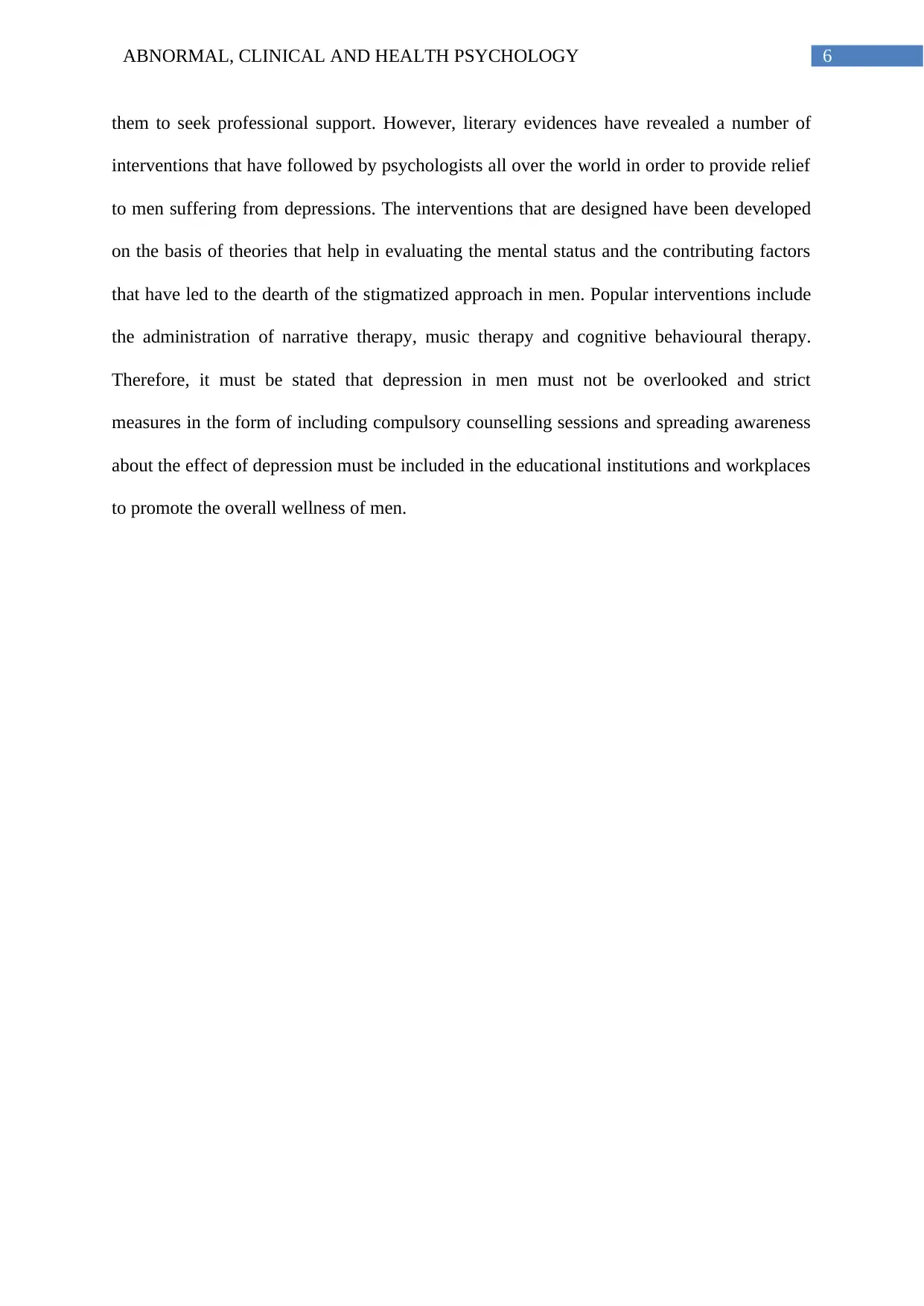
6ABNORMAL, CLINICAL AND HEALTH PSYCHOLOGY
them to seek professional support. However, literary evidences have revealed a number of
interventions that have followed by psychologists all over the world in order to provide relief
to men suffering from depressions. The interventions that are designed have been developed
on the basis of theories that help in evaluating the mental status and the contributing factors
that have led to the dearth of the stigmatized approach in men. Popular interventions include
the administration of narrative therapy, music therapy and cognitive behavioural therapy.
Therefore, it must be stated that depression in men must not be overlooked and strict
measures in the form of including compulsory counselling sessions and spreading awareness
about the effect of depression must be included in the educational institutions and workplaces
to promote the overall wellness of men.
them to seek professional support. However, literary evidences have revealed a number of
interventions that have followed by psychologists all over the world in order to provide relief
to men suffering from depressions. The interventions that are designed have been developed
on the basis of theories that help in evaluating the mental status and the contributing factors
that have led to the dearth of the stigmatized approach in men. Popular interventions include
the administration of narrative therapy, music therapy and cognitive behavioural therapy.
Therefore, it must be stated that depression in men must not be overlooked and strict
measures in the form of including compulsory counselling sessions and spreading awareness
about the effect of depression must be included in the educational institutions and workplaces
to promote the overall wellness of men.
Paraphrase This Document
Need a fresh take? Get an instant paraphrase of this document with our AI Paraphraser
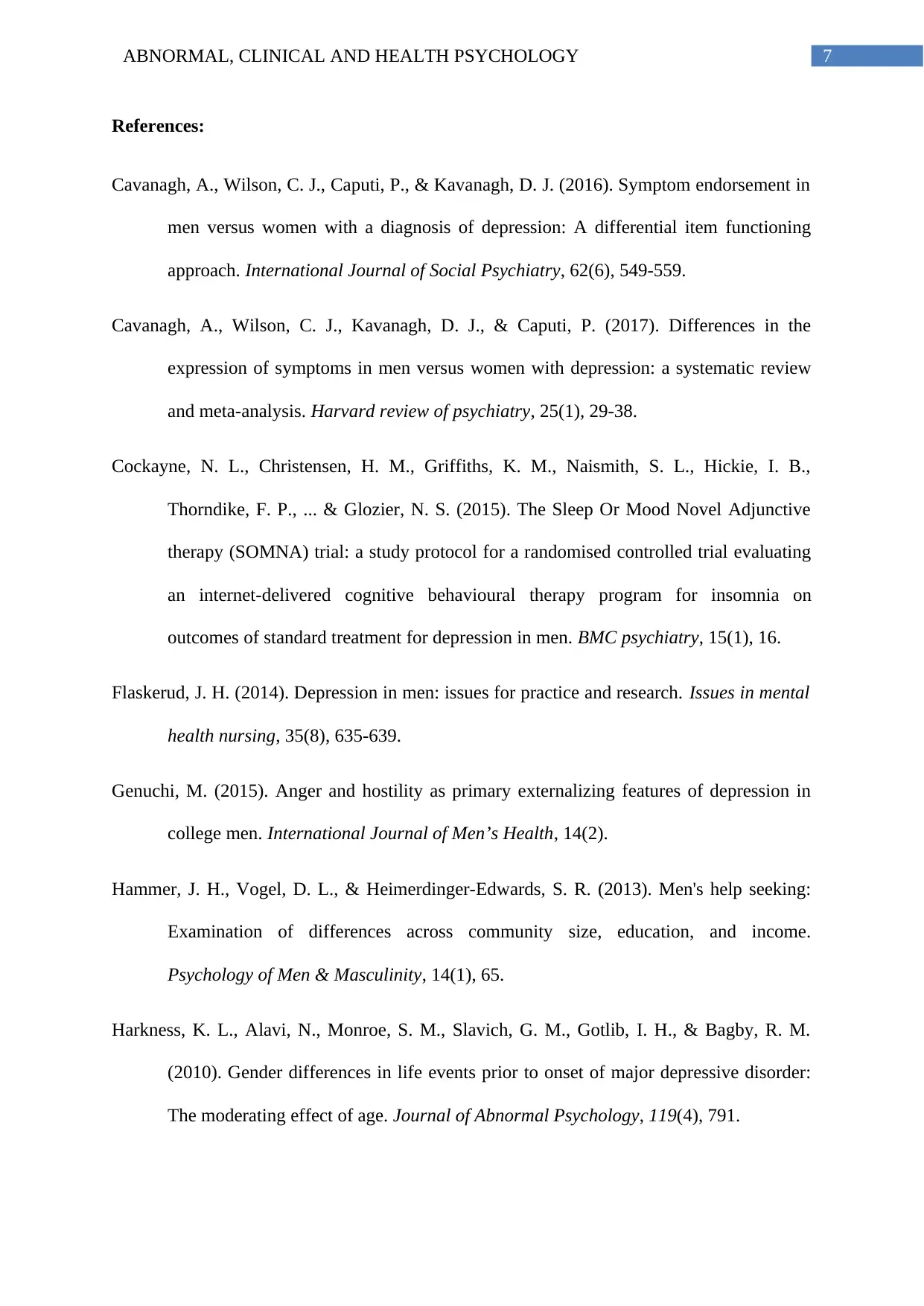
7ABNORMAL, CLINICAL AND HEALTH PSYCHOLOGY
References:
Cavanagh, A., Wilson, C. J., Caputi, P., & Kavanagh, D. J. (2016). Symptom endorsement in
men versus women with a diagnosis of depression: A differential item functioning
approach. International Journal of Social Psychiatry, 62(6), 549-559.
Cavanagh, A., Wilson, C. J., Kavanagh, D. J., & Caputi, P. (2017). Differences in the
expression of symptoms in men versus women with depression: a systematic review
and meta-analysis. Harvard review of psychiatry, 25(1), 29-38.
Cockayne, N. L., Christensen, H. M., Griffiths, K. M., Naismith, S. L., Hickie, I. B.,
Thorndike, F. P., ... & Glozier, N. S. (2015). The Sleep Or Mood Novel Adjunctive
therapy (SOMNA) trial: a study protocol for a randomised controlled trial evaluating
an internet-delivered cognitive behavioural therapy program for insomnia on
outcomes of standard treatment for depression in men. BMC psychiatry, 15(1), 16.
Flaskerud, J. H. (2014). Depression in men: issues for practice and research. Issues in mental
health nursing, 35(8), 635-639.
Genuchi, M. (2015). Anger and hostility as primary externalizing features of depression in
college men. International Journal of Men’s Health, 14(2).
Hammer, J. H., Vogel, D. L., & Heimerdinger-Edwards, S. R. (2013). Men's help seeking:
Examination of differences across community size, education, and income.
Psychology of Men & Masculinity, 14(1), 65.
Harkness, K. L., Alavi, N., Monroe, S. M., Slavich, G. M., Gotlib, I. H., & Bagby, R. M.
(2010). Gender differences in life events prior to onset of major depressive disorder:
The moderating effect of age. Journal of Abnormal Psychology, 119(4), 791.
References:
Cavanagh, A., Wilson, C. J., Caputi, P., & Kavanagh, D. J. (2016). Symptom endorsement in
men versus women with a diagnosis of depression: A differential item functioning
approach. International Journal of Social Psychiatry, 62(6), 549-559.
Cavanagh, A., Wilson, C. J., Kavanagh, D. J., & Caputi, P. (2017). Differences in the
expression of symptoms in men versus women with depression: a systematic review
and meta-analysis. Harvard review of psychiatry, 25(1), 29-38.
Cockayne, N. L., Christensen, H. M., Griffiths, K. M., Naismith, S. L., Hickie, I. B.,
Thorndike, F. P., ... & Glozier, N. S. (2015). The Sleep Or Mood Novel Adjunctive
therapy (SOMNA) trial: a study protocol for a randomised controlled trial evaluating
an internet-delivered cognitive behavioural therapy program for insomnia on
outcomes of standard treatment for depression in men. BMC psychiatry, 15(1), 16.
Flaskerud, J. H. (2014). Depression in men: issues for practice and research. Issues in mental
health nursing, 35(8), 635-639.
Genuchi, M. (2015). Anger and hostility as primary externalizing features of depression in
college men. International Journal of Men’s Health, 14(2).
Hammer, J. H., Vogel, D. L., & Heimerdinger-Edwards, S. R. (2013). Men's help seeking:
Examination of differences across community size, education, and income.
Psychology of Men & Masculinity, 14(1), 65.
Harkness, K. L., Alavi, N., Monroe, S. M., Slavich, G. M., Gotlib, I. H., & Bagby, R. M.
(2010). Gender differences in life events prior to onset of major depressive disorder:
The moderating effect of age. Journal of Abnormal Psychology, 119(4), 791.

8ABNORMAL, CLINICAL AND HEALTH PSYCHOLOGY
Kendler, K. S., & Gardner, C. O. (2014). Sex differences in the pathways to major
depression: a study of opposite-sex twin pairs. American Journal of Psychiatry,
171(4), 426-435.
Martin, L. A., Neighbors, H. W., & Griffith, D. M. (2013). The experience of symptoms of
depression in men vs women: analysis of the National Comorbidity Survey
Replication. JAMA psychiatry, 70(10), 1100-1106.
McCusker, M. G., & Galupo, M. P. (2011). The impact of men seeking help for depression
on perceptions of masculine and feminine characteristics. Psychology of Men &
Masculinity, 12(3), 275.
Parent, M. C., Gobble, T. D., & Rochlen, A. (2018). Social media behavior, toxic
masculinity, and depression. Psychology of Men & Masculinity, pp.260
Ramirez, J. L., & Badger, T. A. (2014). Men navigating inward and outward through
depression. Archives of psychiatric nursing, 28(1), 21-28.
Rice, S. M., Fallon, B. J., Aucote, H. M., & Möller-Leimkühler, A. M. (2013). Development
and preliminary validation of the male depression risk scale: Furthering the
assessment of depression in men. Journal of affective disorders, 151(3), 950-958.
Spendelow, J. S. (2015). Cognitive–behavioral treatment of depression in men: Tailoring
treatment and directions for future research. American journal of men's health, 9(2),
94-102.
Vogel, D. L., Heimerdinger-Edwards, S. R., Hammer, J. H., & Hubbard, A. (2011). “Boys
don't cry”: Examination of the links between endorsement of masculine norms, self-
stigma, and help-seeking attitudes for men from diverse backgrounds. Journal of
Counseling Psychology, 58(3), 368.
Kendler, K. S., & Gardner, C. O. (2014). Sex differences in the pathways to major
depression: a study of opposite-sex twin pairs. American Journal of Psychiatry,
171(4), 426-435.
Martin, L. A., Neighbors, H. W., & Griffith, D. M. (2013). The experience of symptoms of
depression in men vs women: analysis of the National Comorbidity Survey
Replication. JAMA psychiatry, 70(10), 1100-1106.
McCusker, M. G., & Galupo, M. P. (2011). The impact of men seeking help for depression
on perceptions of masculine and feminine characteristics. Psychology of Men &
Masculinity, 12(3), 275.
Parent, M. C., Gobble, T. D., & Rochlen, A. (2018). Social media behavior, toxic
masculinity, and depression. Psychology of Men & Masculinity, pp.260
Ramirez, J. L., & Badger, T. A. (2014). Men navigating inward and outward through
depression. Archives of psychiatric nursing, 28(1), 21-28.
Rice, S. M., Fallon, B. J., Aucote, H. M., & Möller-Leimkühler, A. M. (2013). Development
and preliminary validation of the male depression risk scale: Furthering the
assessment of depression in men. Journal of affective disorders, 151(3), 950-958.
Spendelow, J. S. (2015). Cognitive–behavioral treatment of depression in men: Tailoring
treatment and directions for future research. American journal of men's health, 9(2),
94-102.
Vogel, D. L., Heimerdinger-Edwards, S. R., Hammer, J. H., & Hubbard, A. (2011). “Boys
don't cry”: Examination of the links between endorsement of masculine norms, self-
stigma, and help-seeking attitudes for men from diverse backgrounds. Journal of
Counseling Psychology, 58(3), 368.
⊘ This is a preview!⊘
Do you want full access?
Subscribe today to unlock all pages.

Trusted by 1+ million students worldwide
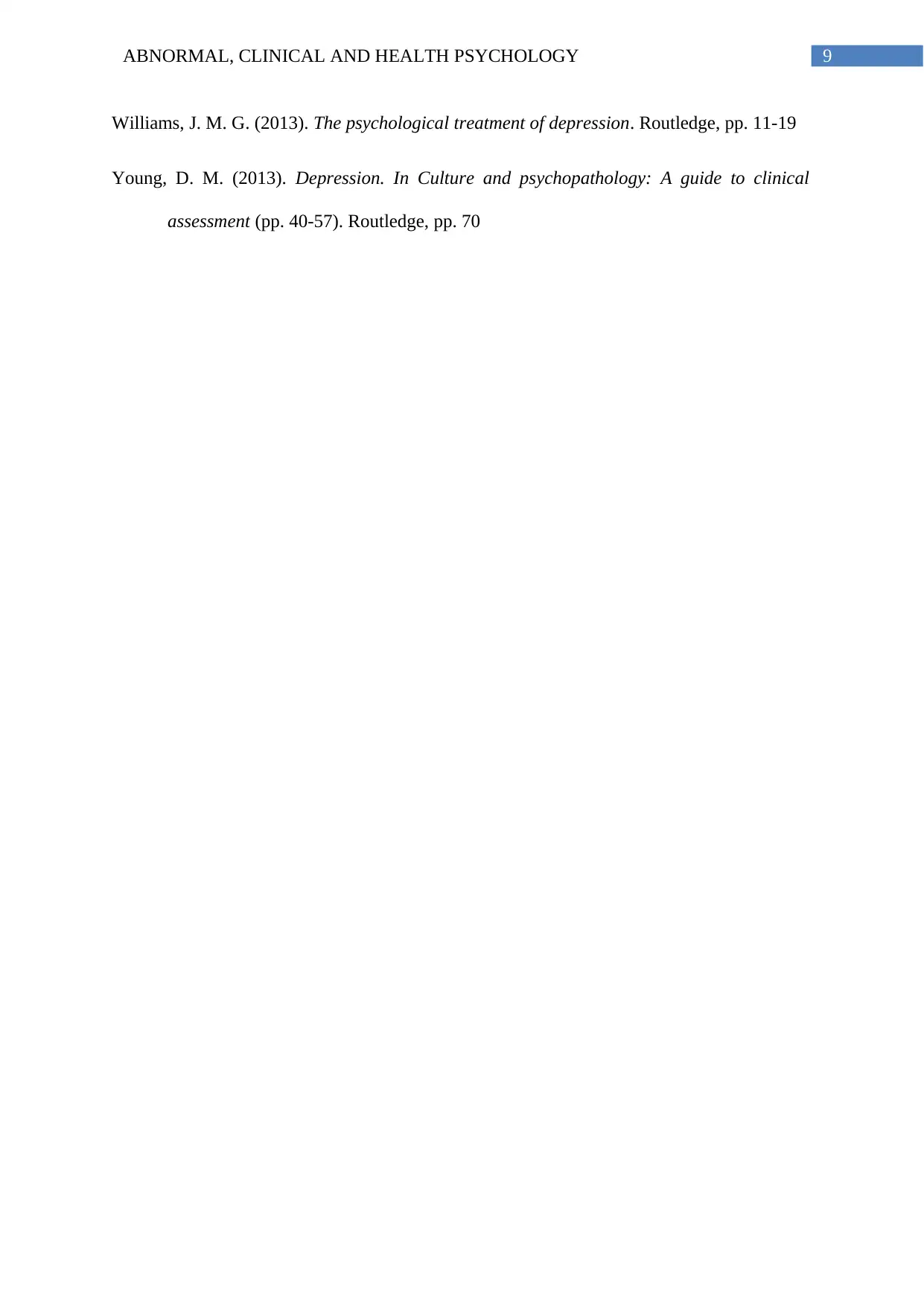
9ABNORMAL, CLINICAL AND HEALTH PSYCHOLOGY
Williams, J. M. G. (2013). The psychological treatment of depression. Routledge, pp. 11-19
Young, D. M. (2013). Depression. In Culture and psychopathology: A guide to clinical
assessment (pp. 40-57). Routledge, pp. 70
Williams, J. M. G. (2013). The psychological treatment of depression. Routledge, pp. 11-19
Young, D. M. (2013). Depression. In Culture and psychopathology: A guide to clinical
assessment (pp. 40-57). Routledge, pp. 70
1 out of 10
Related Documents
Your All-in-One AI-Powered Toolkit for Academic Success.
+13062052269
info@desklib.com
Available 24*7 on WhatsApp / Email
![[object Object]](/_next/static/media/star-bottom.7253800d.svg)
Unlock your academic potential
Copyright © 2020–2025 A2Z Services. All Rights Reserved. Developed and managed by ZUCOL.




